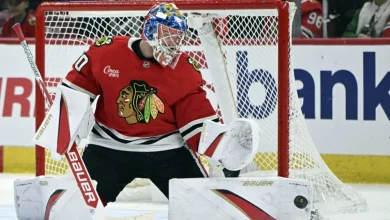Case against Comey appears to be on shaky ground as judge questions prosecutor’s handling of indictment

Washington — The Justice Department’s criminal case against former FBI Director James Comey appears to be on shaky ground as a judge Wednesday repeatedly questioned federal prosecutors about the validity of the indictment returned by a grand jury and how it was handled by interim U.S. Attorney Lindsey Halligan.
During a hearing on Comey’s bid to have the charges tossed on the grounds his prosecution is vindictive and selective, U.S. District Judge Michael Nachmanoff pressed government lawyers for clarity about the events that surrounded the grand jury proceedings on Sept. 25, when it voted to indict Comey on two counts related to testimony he provided to Congress in September 2020. He has pleaded not guilty.
Halligan had said in a declaration filed with the federal court in Alexandria on Friday that after she made her presentation to the grand jury, it deliberated for roughly two hours. Halligan said she was then informed by her deputy that the grand jury had rejected one count, but voted to indict Comey on two others.
The indictment was then re-drafted to remove the first count, and listed only the two counts that the grand jury approved, Tyler Lemons, a federal prosecutor working on Comey’s case, told Nachmanoff on Wednesday. Lemons said a grand-jury coordinator told prosecutors about the outcome of the vote.
Judge has questions about second indictment
But Nachmanoff questioned whether the second indictment — with only the two charges — had been presented to the grand jury and voted on, or given straight to a U.S. magistrate judge. That judge, Lindsey Vaala, presided over the return of the indictment and also expressed confusion as to why she was presented with two documents: The indictment with two counts, and a report of the grand jury’s failure to concur in an indictment, which lists three counts.
Lemons said the second indictment was given straight to the judge, and argued it was not a “new” indictment, but had been edited only to reflect the grand jury’s decision to charge Comey with lying to Congress and obstruction of a congressional proceeding.
Nachmanoff pressed Lemons further, asking if the second indictment was never shown to the entire grand jury. The prosecutor said that was correct. Lemons was not at the proceedings before the grand jury in September. Halligan presented the case by herself.
While Lemons answered most of the judge’s questions, Halligan briefly appeared before Nachmanoff to tell him that only the foreperson and another grand juror were in the courtroom when the indictment was presented to the magistrate judge.
One of Comey’s attorneys, Michael Dreeben, said moments later that the Justice Department had just acknowledged the indictment was never presented to the grand jury and never returned.
“There is no indictment that Mr. Comey is facing,” Dreeben said, adding this is a “threshold basis” to dismiss the case with prejudice, which would prohibit prosecutors from re-filing charges. He said there should be no charges against his client because the five-year statute of limitations for Comey’s alleged offenses has now expired.
Halligan’s presentation before the grand jury and her handling of the indictments have puzzled not only Nachmanoff, but two other judges that have presided over different aspects of Comey’s criminal case, which remains in its early stages.
Earlier hearing raises questions about transcript of Halligan’s grand jury presentation
During a hearing last week on a separate legal issue involving Halligan’s appointment as interim U.S. attorney, U.S. District Judge Cameron Currie raised what she said was a missing portion of the transcript from the grand jury proceedings.
The judge said it appeared no court reporter was present during part of Halligan’s presentation, or did not transcribe the period at issue. Halligan later said in her declaration Friday that the missing portion reflects the time when the grand jury was deliberating, which must be done without any other person in the room, including a court reporter.
“There are no missing minutes, contrary to the suggestion raised by the court,” Halligan wrote.
Another judge raises questions about grand jury transcript
But then, on Monday, U.S. Magistrate Judge William Fitzpatrick raised his own issues with the “completeness” of the transcript and the manner in which the second indictment was presented to the grand jury.
Fitzpatrick said the second indictment was new, and he concluded after reviewing the grand-jury transcript that Halligan would’ve presented it to the grand jury for consideration before it was returned in open court.
“It now appears that may not have happened,” he wrote.
Citing the timeline that Halligan laid out in her filing, the judge said the short time span between when she learned that the grand jury rejected one count in the initial indictment and when she appeared in court to return the second indictment — which is about seven minutes — “could not have been sufficient” to draft and sign the second document, present it to the grand jury, provide legal instructions and give them a chance to deliberate and render a decision.
“If the prosecutor is mistaken about the time she received notification of the grand jury’s vote on the original indictment, and this procedure did take place, then the transcript and audio recording provided to the Court are incomplete,” Fitzpatrick wrote in an order. “If this procedure did not take place, then the Court is in uncharted legal territory in that the indictment returned in open court was not the same charging document presented to and deliberated upon by the grand jury.”
He ordered federal prosecutors to turn over all grand jury material to Comey’s defense team, and criticized the Justice Department for what he described as a “disturbing pattern of profound investigative missteps” in its handling of the case.
Fitzpatrick wrote that there is “the prospect that government misconduct may have tainted the grand jury proceedings.”




